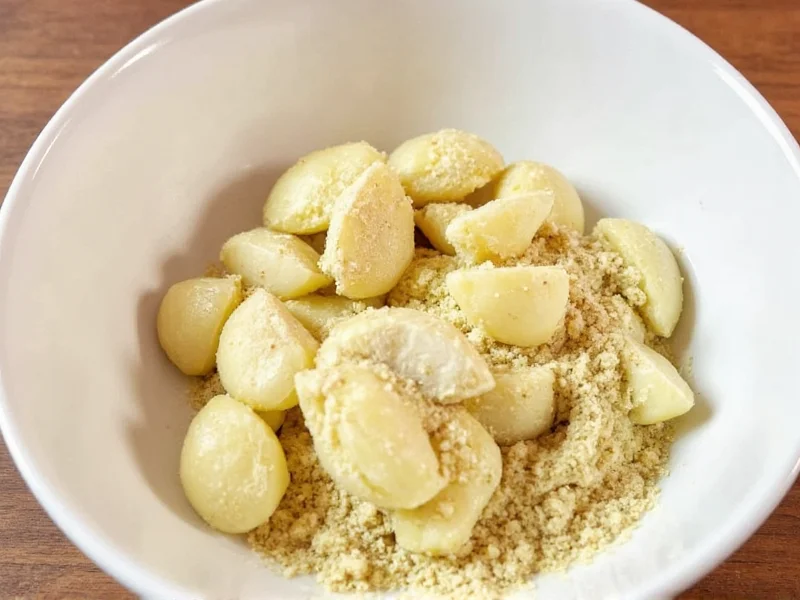One fresh garlic clove equals approximately 1/8 teaspoon of garlic powder. This 3:1 ratio (3 parts fresh garlic to 1 part garlic powder) accounts for the concentrated flavor in dried form. For recipes requiring multiple cloves, use 1/4 teaspoon garlic powder per 2 cloves of fresh garlic.
Understanding Garlic Substitutions in Cooking
When you need to replace garlic cloves with garlic powder, understanding the proper conversion ratio is essential for maintaining your recipe's intended flavor profile. Fresh garlic contains moisture and volatile compounds that give it a bright, pungent flavor, while garlic powder is dehydrated and more concentrated.
Why the Conversion Ratio Matters
Garlic powder packs more intense flavor than fresh garlic due to the removal of water content during the drying process. This concentration means you need less powder to achieve similar flavor intensity. The standard conversion—1 clove fresh garlic to 1/8 teaspoon garlic powder—is based on flavor concentration studies and culinary testing.
Using too much garlic powder can create an overpowering, bitter taste that dominates other ingredients. Conversely, using too little results in a dish lacking the characteristic garlic flavor that balances savory components.
Garlic Conversion Reference Table
| Fresh Garlic | Garlic Powder Equivalent | Best For |
|---|---|---|
| 1 clove | 1/8 teaspoon | Sauces, dressings, marinades |
| 2 cloves | 1/4 teaspoon | Stews, soups, casseroles |
| 3 cloves | 3/8 teaspoon | Dry rubs, spice blends |
| 4 cloves | 1/2 teaspoon | Baked goods, breads |
When to Choose Garlic Powder Over Fresh Garlic
Certain cooking applications benefit from garlic powder's consistent flavor and convenient storage. Understanding garlic powder to fresh garlic conversion helps you make informed decisions:
- Dry rubs and spice blends: Garlic powder distributes evenly without adding moisture
- Long-cooking dishes: Powder won't burn like fresh garlic during extended simmering
- Emergency substitutions: When you've run out of fresh garlic but have powder
- Consistent flavor: Powder provides uniform taste batch-to-batch
Limitations of Garlic Powder Substitution
While convenient, garlic powder doesn't perfectly replicate fresh garlic's complex flavor profile. The enzymatic reaction that creates fresh garlic's characteristic pungency doesn't occur with powder. For dishes where garlic is the star ingredient—like aioli, pesto, or garlic bread—fresh remains superior.
Consider these factors when deciding whether to use garlic powder equivalent to fresh garlic:
- Fresh garlic offers brighter, more complex flavor notes
- Garlic powder lacks the subtle sweetness of roasted fresh garlic
- Powder can develop bitter notes if overheated
- Raw applications (like salad dressings) show the biggest flavor difference
Practical Tips for Successful Substitution
Mastering the art of substituting garlic powder for fresh garlic in recipes requires attention to detail:
- Bloom the powder: Mix garlic powder with a small amount of oil or liquid before adding to dishes to activate flavors
- Adjust gradually: Start with 3/4 of the recommended amount, then taste and adjust
- Consider timing: Add powder early in cooking for milder flavor, later for more pronounced taste
- Account for age: Older garlic powder loses potency—use fresher powder for stronger flavor
- Balance acidity: A splash of vinegar or lemon juice can help replicate fresh garlic's brightness
Storage Considerations for Both Forms
Proper storage affects the potency of both garlic forms, influencing your garlic powder measurement for recipes:
- Fresh garlic: Store in cool, dark place with good air circulation; lasts 3-6 months
- Garlic powder: Keep in airtight container away from light and heat; maintains potency for 2-3 years
Older garlic powder loses flavor intensity, requiring slightly more for equivalent taste. Test your powder by rubbing a small amount between fingers—if the aroma is weak, increase your measurement by 25%.
Common Substitution Mistakes to Avoid
Many home cooks make these errors when attempting cooking with garlic powder instead of fresh:
- Using equal volumes (1:1 ratio) resulting in overpowering flavor
- Adding powder directly to hot oil causing burning and bitterness
- Not accounting for recipe moisture content (dry vs. wet dishes)
- Using garlic salt instead of pure garlic powder, altering sodium levels
- Substituting in raw applications where fresh garlic's texture matters
For the most accurate results when determining how much garlic powder equals one clove, consider your specific recipe's requirements and make small adjustments based on taste testing.











 浙公网安备
33010002000092号
浙公网安备
33010002000092号 浙B2-20120091-4
浙B2-20120091-4